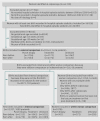Risk of preterm birth after treatment for cervical intraepithelial neoplasia among women attending colposcopy in England: retrospective-prospective cohort study
- PMID: 22899563
- PMCID: PMC3421237
- DOI: 10.1136/bmj.e5174
Risk of preterm birth after treatment for cervical intraepithelial neoplasia among women attending colposcopy in England: retrospective-prospective cohort study
Abstract
Objective: To explore the association between preterm delivery and treatment at colposcopy.
Design: Retrospective-prospective cohort study using record linkage.
Setting: 12 National Health Service hospitals in England.
Participants: Women who had a cervical histology sample taken between 1987 and 2009. These women were linked by hospital episode statistics to hospital obstetric records between 1998 and 2009 for the whole of England to identify singleton live births between 20-43 gestational weeks before or after cervical histology.
Main outcome measures: Proportion of preterm births (<37 weeks); the relative risk for the strength of association between preterm births and treatment for cervical intraepithelial neoplasia.
Results: 18,441 singleton births occurred: 4176 before histology and 14,265 after histology. Of the singleton births after histology, 9.0% (n=1284) were preterm compared with 6.7% of all births in England over the same period (excess risk 2.3 per 100 births, 95% confidence interval 1.8% to 2.8%). Among first births after histology, the adjusted relative risk associated with previous treatment was 1.19 (95% confidence interval 1.01 to 1.41); among first births before histology the relative risk associated with subsequent treatment was 1.47 (1.05 to 2.05). Combining these, the relative risk associated with treatment adjusted for timing relative to histology was 0.91 (0.66 to 1.26) corresponding to an absolute difference of -0.25 (-2.61 to 2.11) per 100 singleton births. Among 372 women who gave birth both before and after treatment, there were 30 preterm births after treatment and 32 before treatment (relative risk 0.94, 0.62 to 1.43).
Conclusion: The risk of preterm delivery in women treated by colposcopy in England was substantially less than that in many other studies, predominantly from Nordic countries. The increased risk may be a consequence of confounding and not caused by treatment. Although this study is reassuring for large loop excision of the transformation zone overall, it is possible that deep conisation or repeated treatment leads to an increased risk of preterm delivery.
Conflict of interest statement
Competing interests: All authors have completed the ICMJE uniform disclosure form at
Figures
Comment in
-
Increased risk of preterm birth after treatment for CIN.BMJ. 2012 Sep 4;345:e5847. doi: 10.1136/bmj.e5847. BMJ. 2012. PMID: 22951549 No abstract available.
References
-
- Lancucki L, ed. Cervical screening programme, England: 2005-06. NHS Information Centre, 2006.
-
- Luesley DLS, ed. NHS cervical screening programme. Colposcopy and programme management. Guidelines for the NHS cervical screening programme. NHS Information Centre, 2004.
-
- Kyrgiou M, Koliopoulos G, Martin-Hirsch PL, Arbyn M, Prendiville W. Obstetric outcome after conservative treatment for intraepithelial or early invasive cervical lesions: systematic review and meta-analysis. Lancet 2006;367:489-98. - PubMed
-
- Reilly R, Paranjothy S, Beer H, Brooks C, Fielder H, Lyons R. Birth outcomes following treatment for precancerous changes to the cervix: a population-based record linkage study. BJOG 2012;119:236-44. - PubMed



